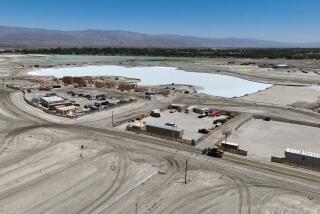‘86 Shapes Up as Brisk Year for Housing Sales : 108,000 to 110,000 Units Expected to Be Built in Los Angeles, Orange and Riverside Counties
With interest rates at a seven-year low and the economy maintaining continued vigor, 1986 looks as if it will be a brisk year for new and existing housing sales in Orange County.
Orange County will be part of the busiest residential building area in the state with 108,000 to 110,000 new dwelling units planned this year for Orange, Los Angeles and Riverside counties, said Sanford Goodkin, a La Jolla-based real estate analyst. Housing construction in the tri-county area will be about three times higher than the activity expected this year in the San Francisco Bay area, the second most active housing construction market.
Sales of existing houses in Orange County are also expected to be brisk, and resale activity appears to be strong throughout the county. Sandy Khadra, marketing director at Grub & Ellis, said resale activity is strong at all seven of the company’s county offices.
“From all indications, the overall outlook for 1986 is very positive,” said Betty Bailey, a spokeswoman for the Newport Harbor-Costa Mesa Board of Realtors, a trade group that represents about 2,000 realtors. Her view is repeated by realtors and analysts around the county.
Looking for Better Year
“Our office had one of its best years last year, and we are looking to do as well or better this year,” said Noel Johnson, sales manager for the Laguna Beach residential sales office of Grubb & Ellis Co., a San Francisco-based real estate concern.
Orange County’s muscular economy is supporting the growth in housing, and the surge in construction of houses, condominiums and apartments means choices are plentiful for buyers lured by interest rates that now hover in the 11% range. While experts agree that interest rates are unlikely to dip further this year, they also say that they won’t climb much.
And while the relatively low interest rates have spurred a minor comeback for fixed-rate mortgages, adjustable rates are a key feature of about half the mortgage loans made today and are “the mortgage of the future,” said Tim McGarry, a spokesman for the Los Angeles-based California League of Savings Institutions.
Sales of existing houses in Orange County rose 1.7% in 1985 compared to the prior year, the California Assn. of Realtors said, but the median price surged to $144,154, an 11.2% gain from the 1984 median price of $129,647. In 1983, the median price was $133,695.
Resale Action Expected
Because buyers tend to wait until falling interest rates appear to level off or even begin rising again, resale activity should be brisk for the next six months, said Kevin Sweeney, a spokesman for the state association. Beyond six months, the variables of the federal budget and other uncertainties make forecasting difficult, he said.
In the early 1980s, the sharp slowdown in residential price inflation in Orange County choked the move-up market which had accelerated in the 1970s, the years of double-digit annual increases in house prices. But with prices once again on the ascent, the move-up market is gathering strength, real estate industry specialists say.
“Orange County is a strong (resale) market, there’s no doubt about it,” Sweeney said.
The rise in resale activity illustrates one of two diverse housing trends in Orange County and the state for 1986--resales are expected to be strong because of a rekindled move-up market, fueled by buyers whose present homes have increased in value and who want to take their equity and use it to help pay for a larger dwelling.
But most experts say the general trend, especially for first-time buyers, is still to smaller houses on ever-smaller lots--the only way developers can keep a lid on prices in an area of rapid growth and prime land such as Orange County.
Smaller Houses, Smaller Lots
For example, the Irvine Pacific Development Co., a unit of the Irvine Co., is building up to eight small houses per acre at its Vista Filare project near Interstate 5 at Culver Drive in Irvine. The two-, three- and four-bedroom houses sell for $138,000 to $158,000 and contain 1,050 to 1,590 square feet. When complete in May, the project will contain 268 detached houses. As recently as a decade ago, the standard tract contained six or fewer homes per acre, and the smallest homes averaged 1,200 square feet.
Because of environmental concerns and zoning hurdles, most of the new housing in Orange County for the remainder of the ‘80s will be in even larger master-planned projects such as 5,000-acre Rancho Santa Margarita east of Mission Viejo and 5,000-acre Coto de Caza, a 6,410-unit housing project east of Rancho Santa Margarita. Some custom houses already have been built at Coto de Caza, and further condo and detached-house projects are being developed. The company expects the price range of the homes to be from $135,000 to $350,000.
In May, the first phase of a planned total of 16,000 dwellings will go on sale at Rancho Santa Margarita. The entire project, which is expected to take 15 to 20 years to complete, will include apartments, condos and detached houses with initial prices ranging from about $60,000 to $180,000.
Included in the project is a 400-acre business park and sites for shopping areas, churches and schools. More than half the project area will remain in open space, but Rancho Santa Margarita eventually will be “a city all its own--no question about it,” said Ken Agid, an Irvine-based real estate marketing consultant.
The Planned Community
Besides being a “major trend” in Orange County and California, the master-planned community concept is spreading to Arizona and Texas, Agid said.
The mix of housing units at Rancho Santa Margarita and Coto de Caza probably will help keep the county’s housing stock in balance. Except for Orange County and the San Diego area, most areas of the state have a surplus of condos and thus are experiencing a “softening” of prices, said Goodkin.
Dampening the heady optimism of first-time buyers are more stringent guidelines for qualifying for loans. In recent years, lenders typically had allowed a borrower’s monthly payments to run as high as a third of the borrower’s gross monthly income, but the high rate of foreclosures and delinquencies has prompted a tightening of that standard.
More to Read
Inside the business of entertainment
The Wide Shot brings you news, analysis and insights on everything from streaming wars to production — and what it all means for the future.
You may occasionally receive promotional content from the Los Angeles Times.










